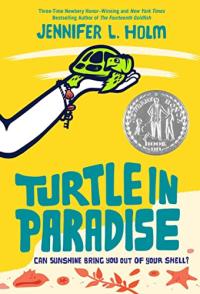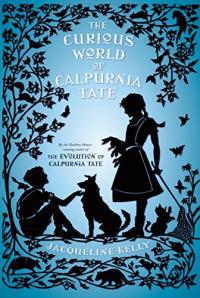
As the older woman, Ms Lillian, walks a steep hill to vote. While walking, she remembers the precipitous climb that those who preceded her made so that she could cast her ballot. The storyteller’s tone of the text and dramatic illustrations tell a powerful story.
Lillian’s Right to Vote: A Celebration of the Voting Rights Act of 1965

A full cast voices this production which brings to life the summer of 1964 and the changes that were taking place in Greenwood, Mississippi.
Revolution (The Sixties Trilogy)

Delphine is now twelve years old in this third (and final book) about her, and her younger sisters. The girls are sent to Alabama where they are supposed to come to know their grandmother, great grandmother, and other family members. Instead, the girls are caught up in a family feud and learn that adults, too, have issues. Things change radically when Vonetta goes missing during a tornado. Family history and sibling loyalty are strong themes in this engaging conclusion.
Gone Crazy in Alabama

It’s 1953 and 11-year-old Penny dreams of a summer of butter pecan ice cream, swimming, and baseball. This coming-of-age story is populated by a cast of vivid family characters and it explores the things that tear them apart and the things that bring them back together. The book includes an Author’s Note with photographs and additional background on World War II, Internment camps, and 1950s America.
Penny from Heaven

Twelve-year-old tomboy May Amelia Jackson, the youngest of seven children and the only girl in a Finnish immigrant family, lives in the wilderness along the Nasel River in Washington State in 1899. Through May Amelia’s travels, readers witness the diverse ways of life in the expanding West: peaceful relations with the Chinook Indians, the dangers posed by the neighboring logging camp, her aunt’s life in the nearby boomtown of Astoria, Oregon, as well as the rhythms of the seasons.
Our Only May Amelia

In 1935, jobs are hard to come by, and Turtle’s mother is lucky to find work as a live-in housekeeper. When she learns that her employer can’t stand children, she sends her 11-year-old daughter from New Jersey to Key West to live with relatives. Turtle discovers a startlingly different way of life amid boisterous cousins, Nana Philly, and buried treasure. This richly detailed novel was inspired by Holm’s great-grandmother’s stories.
Turtle in Paradise

Orphaned at birth, Lanesha has second sight, giving her the ability to see her mother’s ghost. She also senses an impending storm which will devastate New Orleans and that her grandmother won’t survive. How Lanesha stays alive and the people she meets and helps along the way — plus a bit of magic realism — create a compelling read. See the two other two books in the Louisiana Girls Trilogy, Bayou Magic (opens in a new window) and Sugar (opens in a new window).
Ninth Ward

Jack and Annie are transported back to Normandy, France, when Europe is in danger of falling to the Germans and the D-Day invasion is about to begin. Though necessarily simplified, this adventure gives an age appropriate introduction to WWII. “Track the Facts” concludes this “super edition” of the popular Magic Tree House series.
Danger in the Darkest Hour

Could one of Gilbert Stuart’s 12 children get President George Washington to smile while having his portrait painted? In this richly imagined, humorous fictional account of what the president experienced while sitting for his portrait in Stuart’s home is revealed through a lively correspondence and expressive line and wash illustrations.
Dear Mr. Washington

Girls didn’t always have the freedom to choose what they wanted to do. This is certainly true for Callie Tate, the only girl in her family. How she follows her interests and deals with not being taken seriously is revealed in rich, well-paced language. Callie’s story started in The Evolution of Calpurnia Tate though both books can be read without the other. Both will appeal to sophisticated readers.
The Curious World of Calpurnia Tate

Lonnie travels back in time to meet many of the artists, writers, and musicians of the Harlem Renaissance. During this rich time, African American culture was reinvigorated. Illustrations are boldly colored acrylic paintings, and additional information is included at the end.
Harlem Renaissance Party

For Rosa and her family, Emancipation means education and schooling. The child’s narration accompanied by richly hued illustrations, reveals the strength in community and the power of learning in the face of adversity and opposition in a post-Civil War South.
Freedom’s School

Charlie, a young British soldier, tells of an experience he had on a battlefield in France in 1914. Based on an actual event during World War I — framed by the fictional soldier’s letter to his mother and illustrated by evocative illustrations — a touching bit of history is brought to light for younger but sophisticated readers.
Shooting at the Stars: The Christmas Truce of 1914

On a sunny summer day long ago, a boy planted an acorn. From that grew an oak tree that survived for more than two centuries until it was felled by lightning. Simple but lush illustrations depict the evolution of the world surrounding the oak and how it remained useful in the “furniture, firewood and mulch.” And soon, another oak begins to grow.
As an Oak Tree Grows

Soon after 13-year old Zane travels from New Hampshire to visit his great-grandmother, Miss Trissy, in New Orleans, disaster strikes. He and Bandy, his dog, confront the storm and the natural and human disastrous aftermath when they are separated from Miss Trissy and make their way back to Zane’s family. This thought-provoking novel is taut and fast-paced.
Zane and the Hurricane: A Story of Katrina

The rumors of a Russian spy in Hazel’s small Vermont town and the threat of Communist infiltration are palpable to her. With the help of a new kid in town and a bit of spying, Hazel tries to uncover the goings-on. Though set in the 1950s, themes remain relevant in this fast-paced adventure.
The Spy Catchers of Maple Hill

Sisters, Marcelle and Coco, find a blind English soldier in the woods near their home in France. With the help of their older brother and his friend, Lt. Shepherd makes it across the Channel, leaving a small silver donkey and stories about the creature with the girls. Set during World War I, this is a timeless, gentle and hopeful story.
The Silver Donkey

Mason is quietly determined to do his best in spite of the obstacles he faces. One of the few African American students in his school, Mason wins a typing contest on a manual typewriter. The author based this quietly triumphant story on her father’s experiences growing up in the 1960s. Realistic illustrations evoke the period and the place.
As Fast as Words Could Fly

An illustration of a contemporary boy with pencil in hand stands in front of a blank piece of paper, invites readers to “Imagine…you were born before the invention of drawing…” And so starts Gerstein’s exploration of the boy who created the first drawing, created with a charred stick on a cave wall.
The First Drawing

Ivy lives on a Nevada ranch with her parents. During the summer of 1949, with her best friend gone, Ivy’s gentle ways and affinity for animals leads to unexpected adventures and a job with a veterinarian, causing Ivy to dream of one day becoming one.
Ivy Takes Charge

Tai Shan and his father fly kites from “the tippy-top of our triangle roof” where they are free like the kites. Tai Shan’s is small, nimble, and red while Baba’s is a strong, large blue kite. The widow and his son are separated during China’s Cultural Revolution though are ultimately reunited. A difficult period is touchingly presented while remaining child-friendly.
Red Kite, Blue Kite

Inspired by an actual artist, Wu Daozi’s brush created images that seemed to come alive. Travel to ancient China to meet Daozi as he grows from a boy into a muralist for the Emperor. When the mural is finished, legend says that Daozi walks into the paradise he painted. Brief text combines with brush and watercolor illustrations for a memorable look at a legendary Chinese painter.
Brush of the Gods

This unapologetically goofy picture book reveals that the legendary ride to town (and the whole macaroni thing) was all suggested by Mr. Doodle’s overeager pony. A historical note ends this colorful, comical take on a nonsensical old song.
Crankee Doodle

Stonewall Hinkleman’s parents are Civil War buffs who reenact its battles, insisting that Stonewall (named for Stonewall Jackson, of course) accompany them. When Stonewall Hinkleman finds has traveled back in time to a real battle, he must work to save history!
